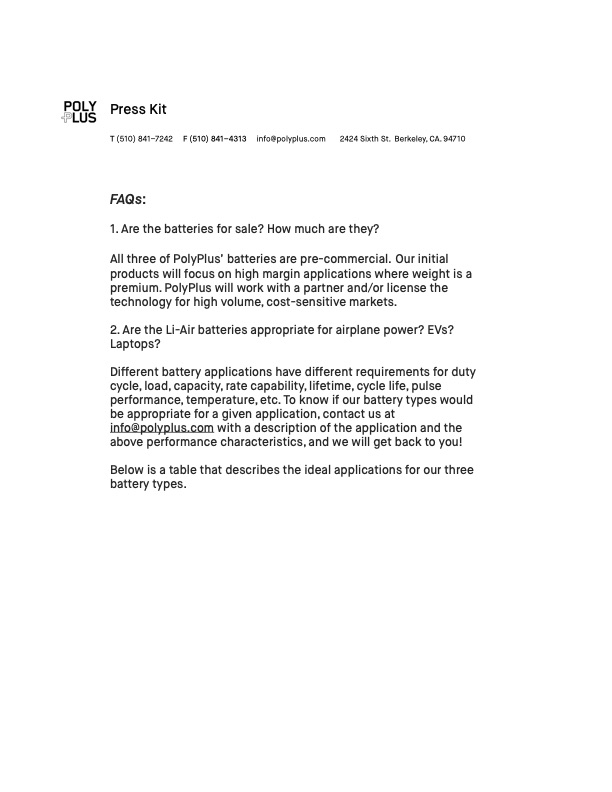
PDF Publication Title:
Text from PDF Page: 005
Press Kit T (510) 841–7242 F (510) 841–4313 info@polyplus.com 2424 Sixth St. Berkeley, CA. 94710 FAQs: 1. Are the batteries for sale? How much are they? All three of PolyPlus’ batteries are pre-commercial. Our initial products will focus on high margin applications where weight is a premium. PolyPlus will work with a partner and/or license the technology for high volume, cost-sensitive markets. 2. Are the Li-Air batteries appropriate for airplane power? EVs? Laptops? Different battery applications have different requirements for duty cycle, load, capacity, rate capability, lifetime, cycle life, pulse performance, temperature, etc. To know if our battery types would be appropriate for a given application, contact us at info@polyplus.com with a description of the application and the above performance characteristics, and we will get back to you! Below is a table that describes the ideal applications for our three battery types.PDF Image | Li-Seawater batteries

PDF Search Title:
Li-Seawater batteriesOriginal File Name Searched:
press-kit-v3.pdfDIY PDF Search: Google It | Yahoo | Bing
Product and Development Focus for Salgenx
Redox Flow Battery Technology: With the advent of the new USA tax credits for producing and selling batteries ($35/kW) we are focussing on a simple flow battery using shipping containers as the modular electrolyte storage units with tax credits up to $140,000 per system. Our main focus is on the salt battery. This battery can be used for both thermal and electrical storage applications. We call it the Cogeneration Battery or Cogen Battery. One project is converting salt (brine) based water conditioners to simultaneously produce power. In addition, there are many opportunities to extract Lithium from brine (salt lakes, groundwater, and producer water).Salt water or brine are huge sources for lithium. Most of the worlds lithium is acquired from a brine source. It's even in seawater in a low concentration. Brine is also a byproduct of huge powerplants, which can now use that as an electrolyte and a huge flow battery (which allows storage at the source).We welcome any business and equipment inquiries, as well as licensing our flow battery manufacturing.| CONTACT TEL: 608-238-6001 Email: greg@salgenx.com | RSS | AMP |